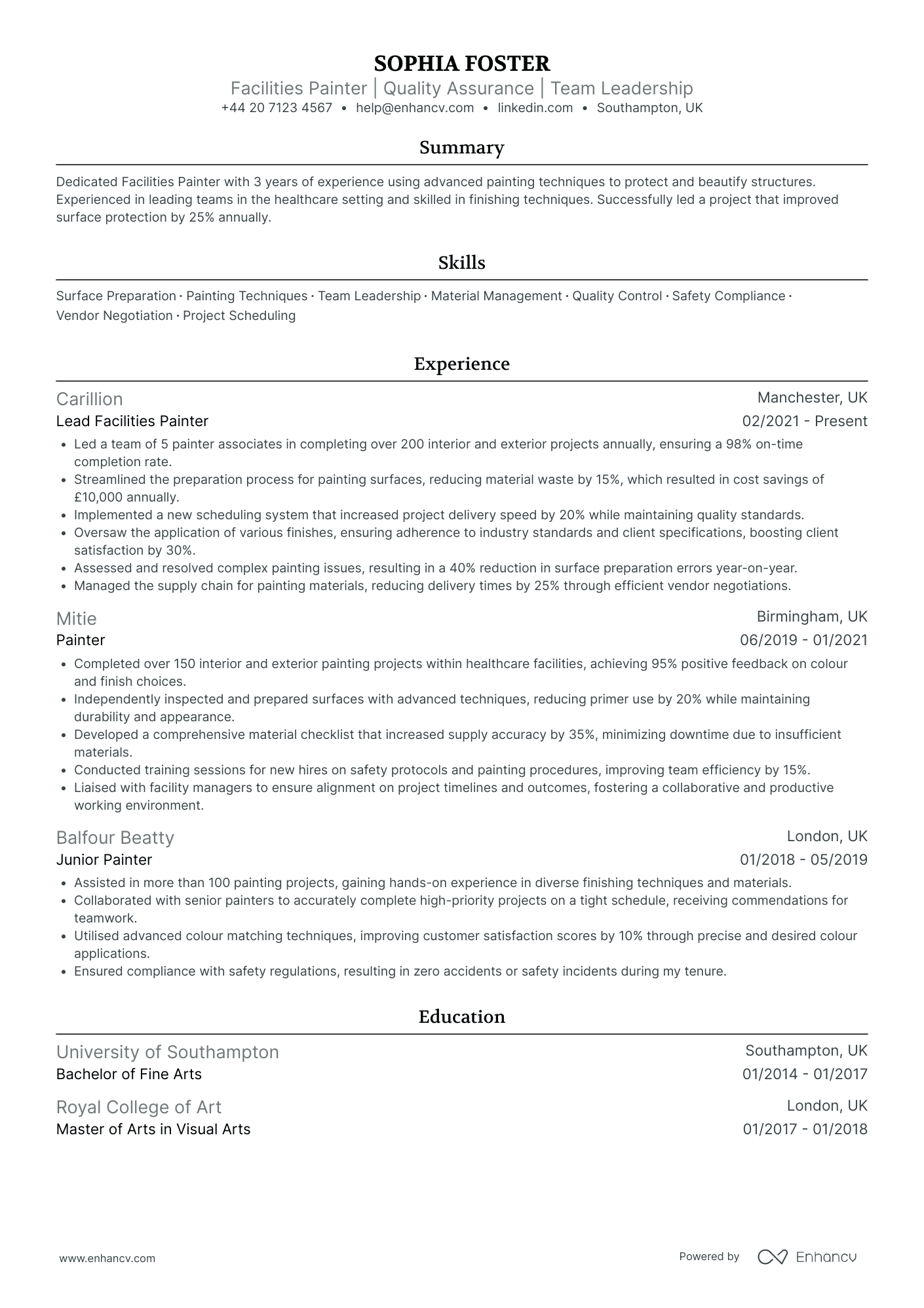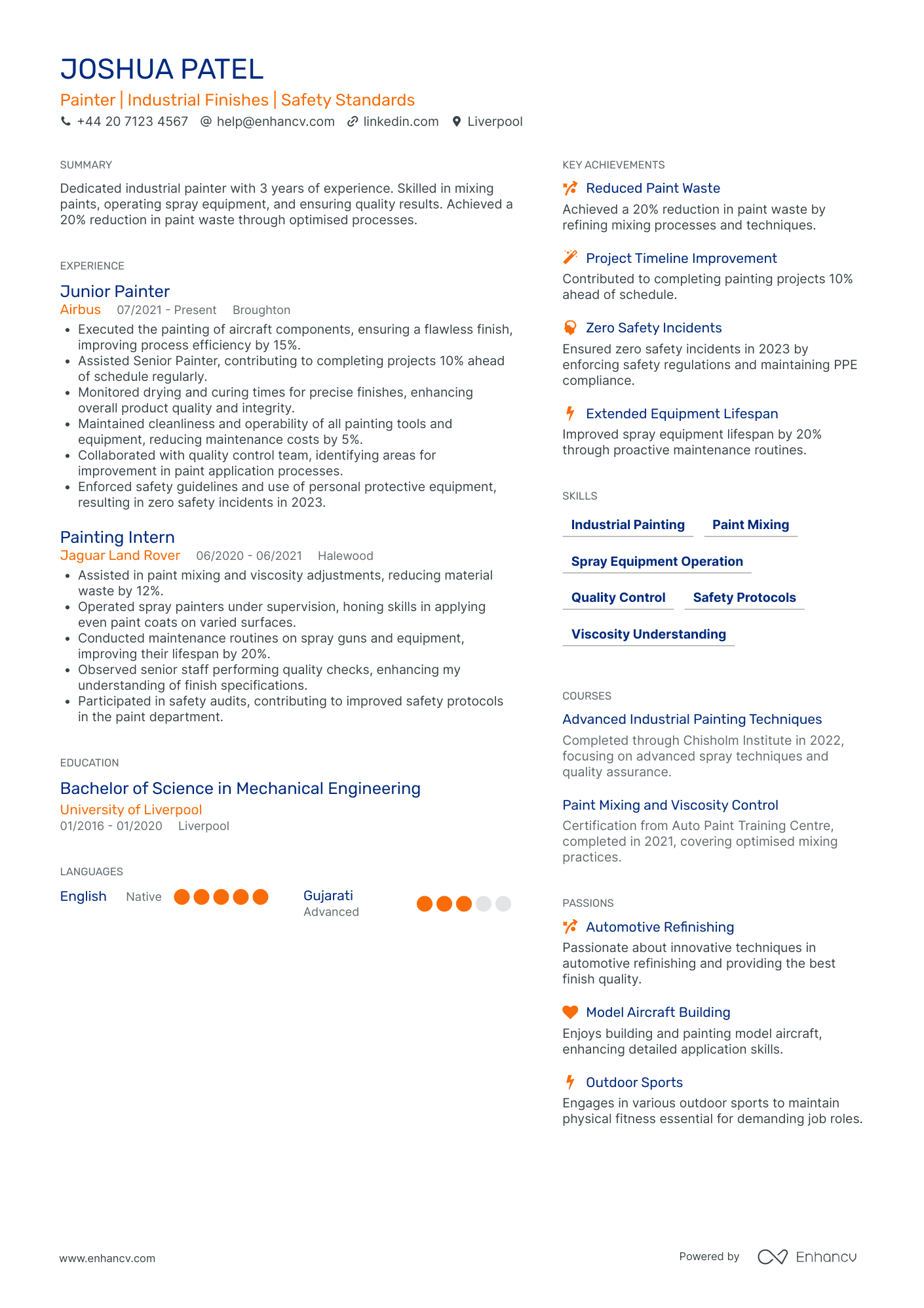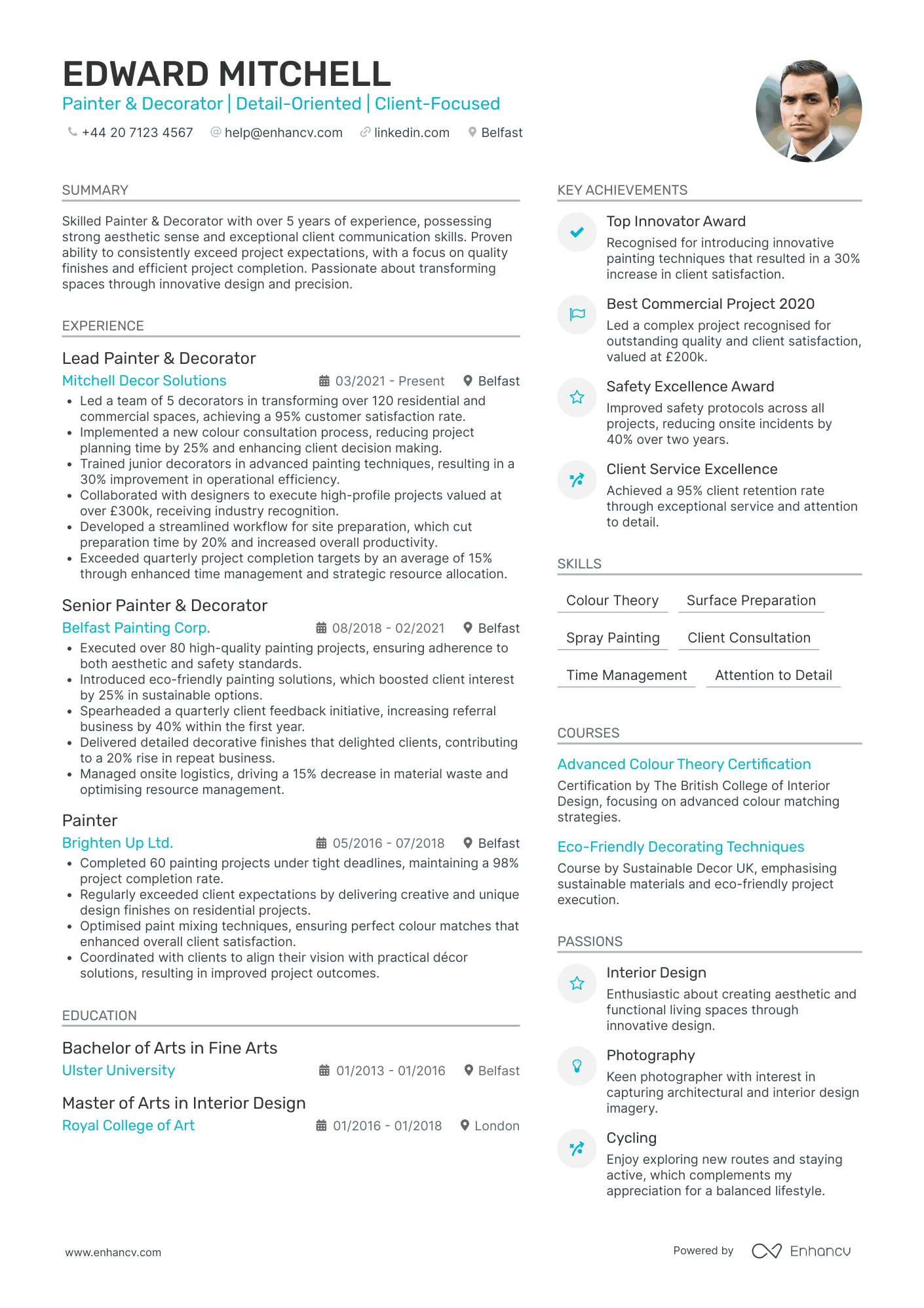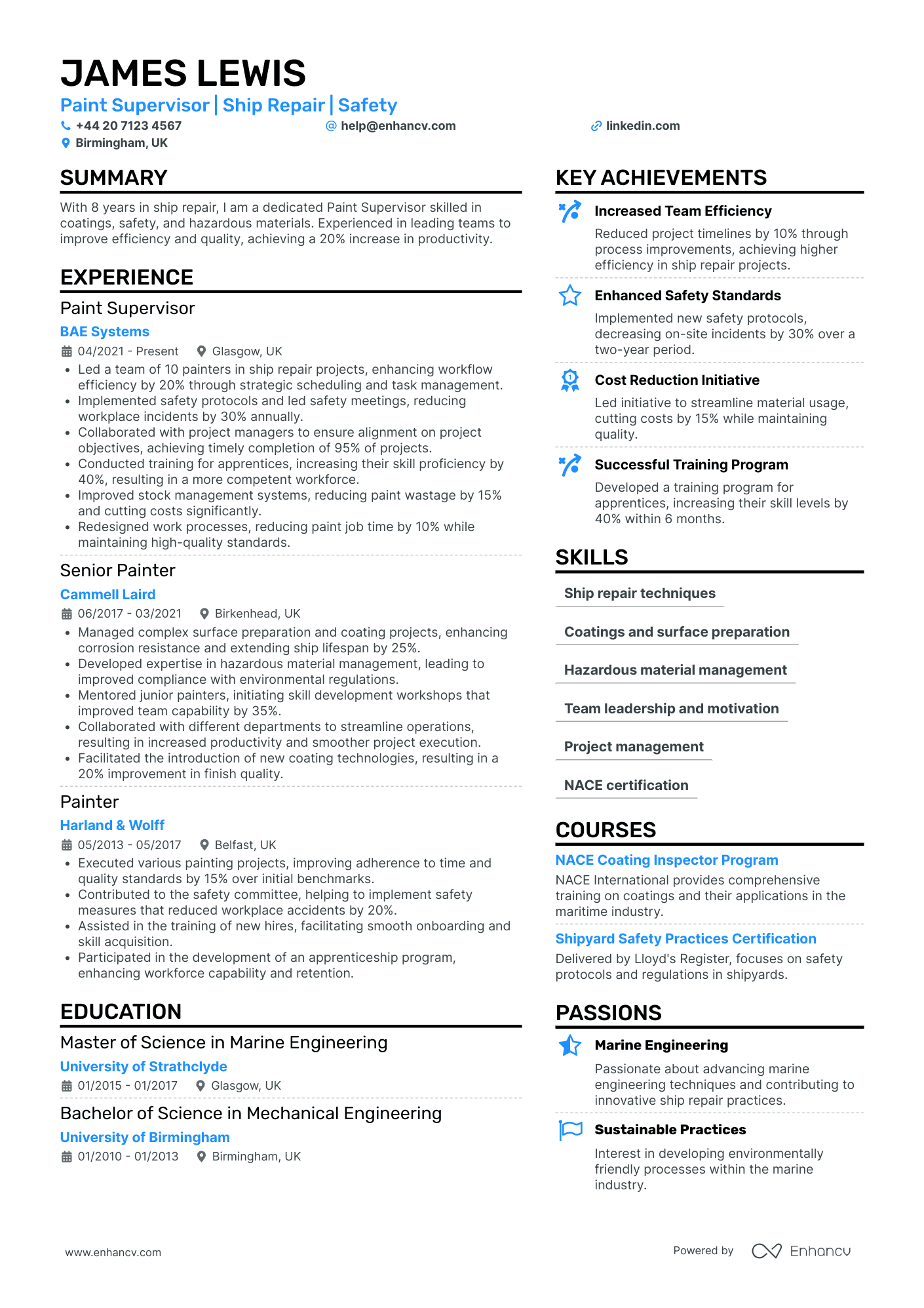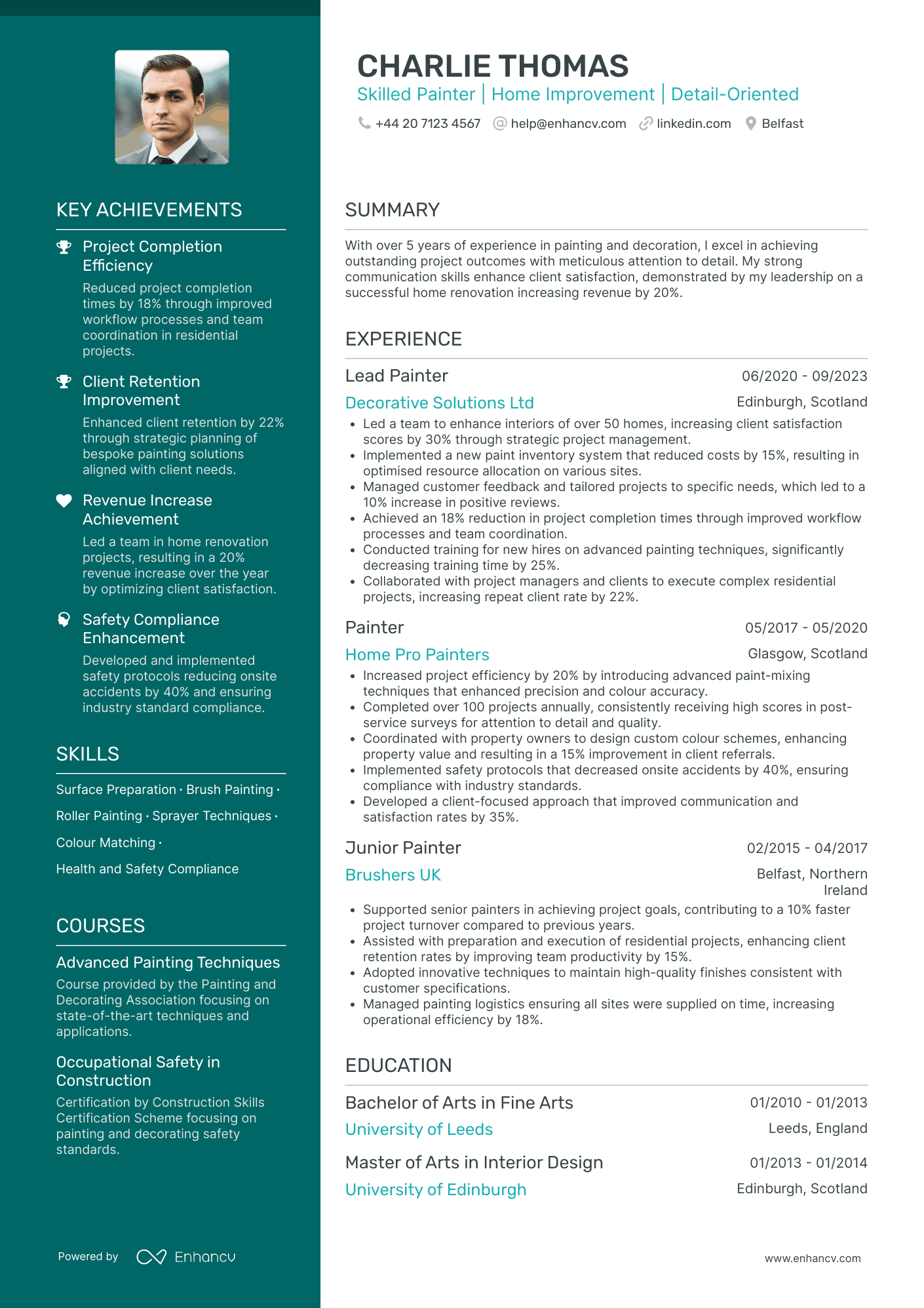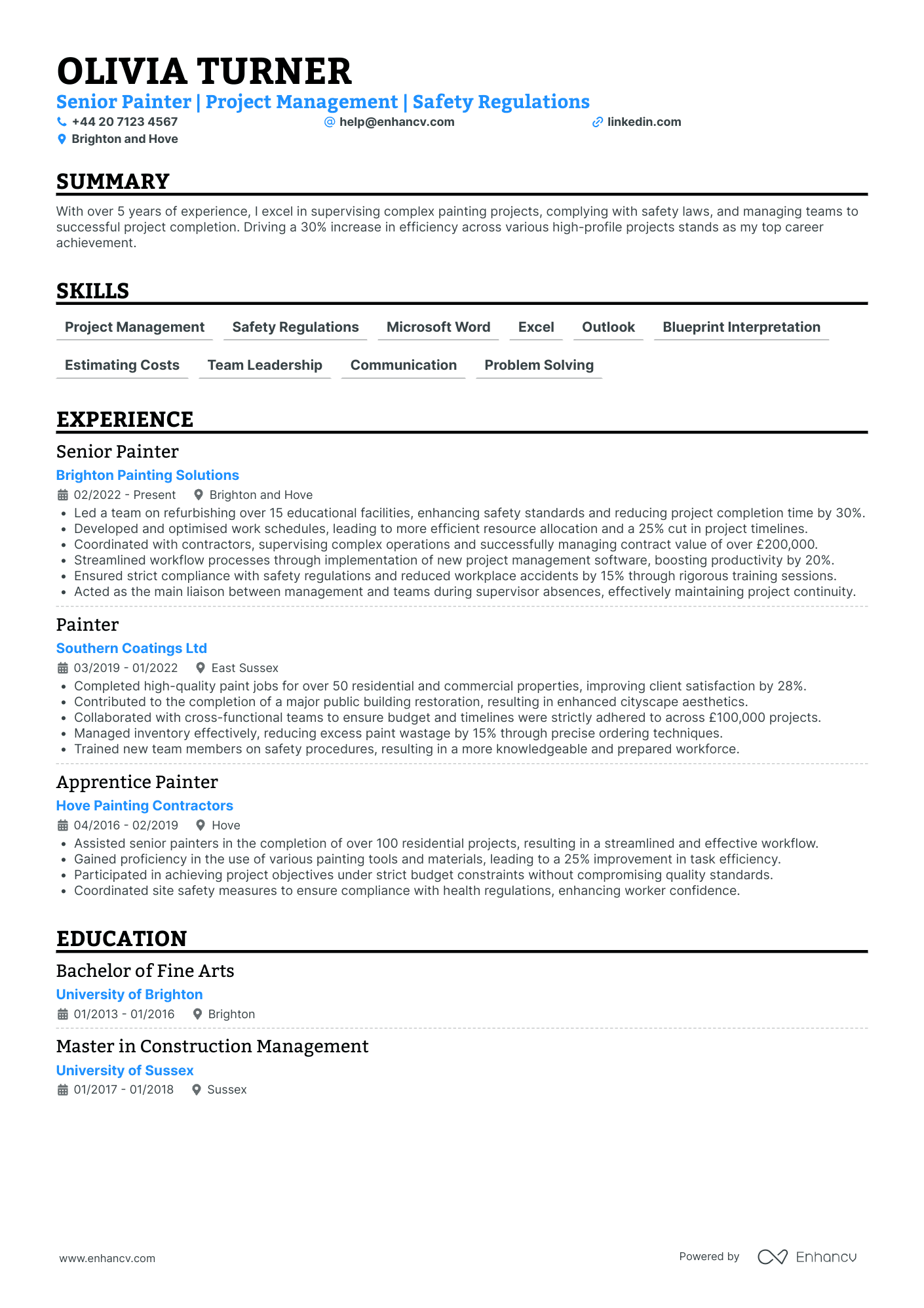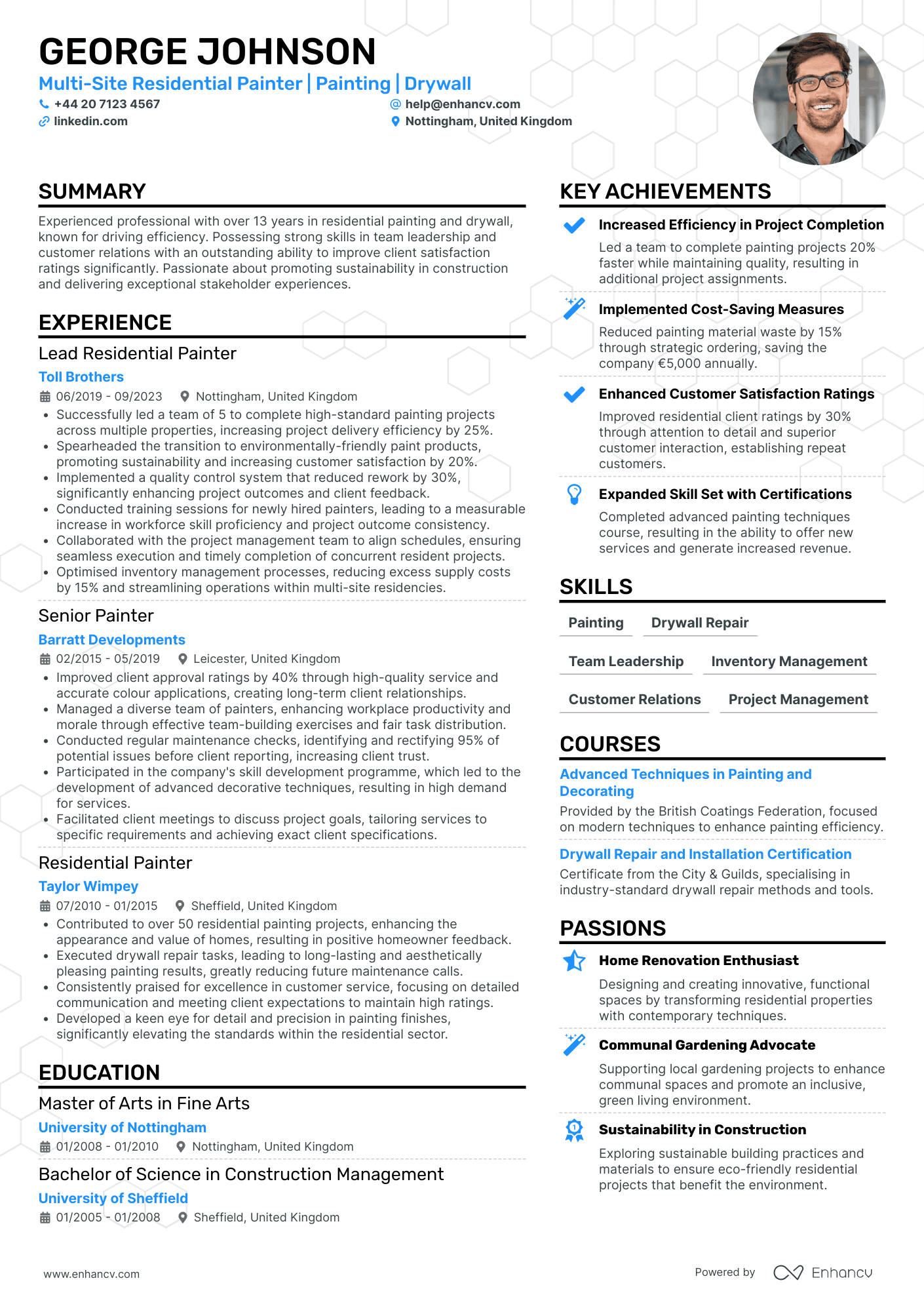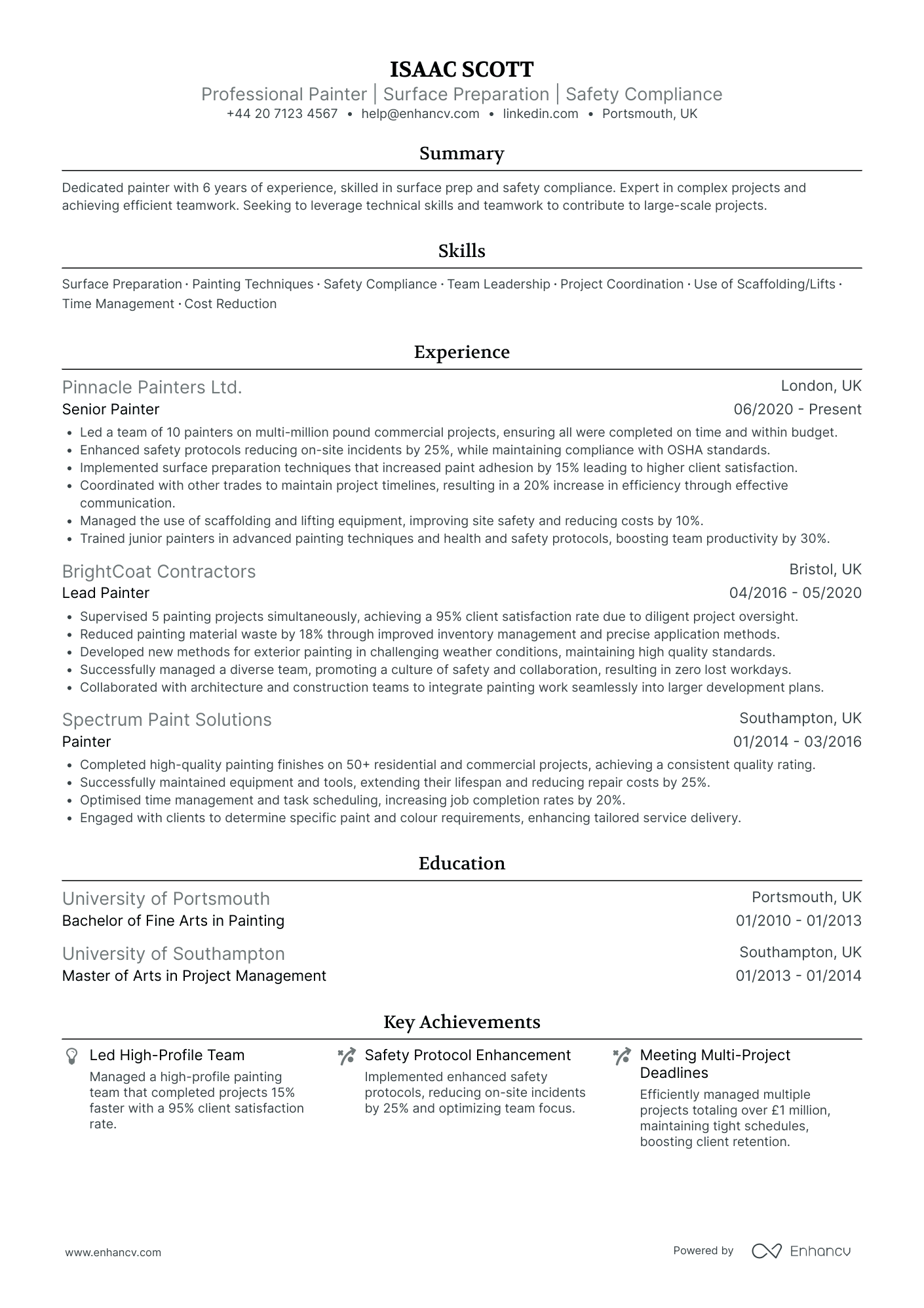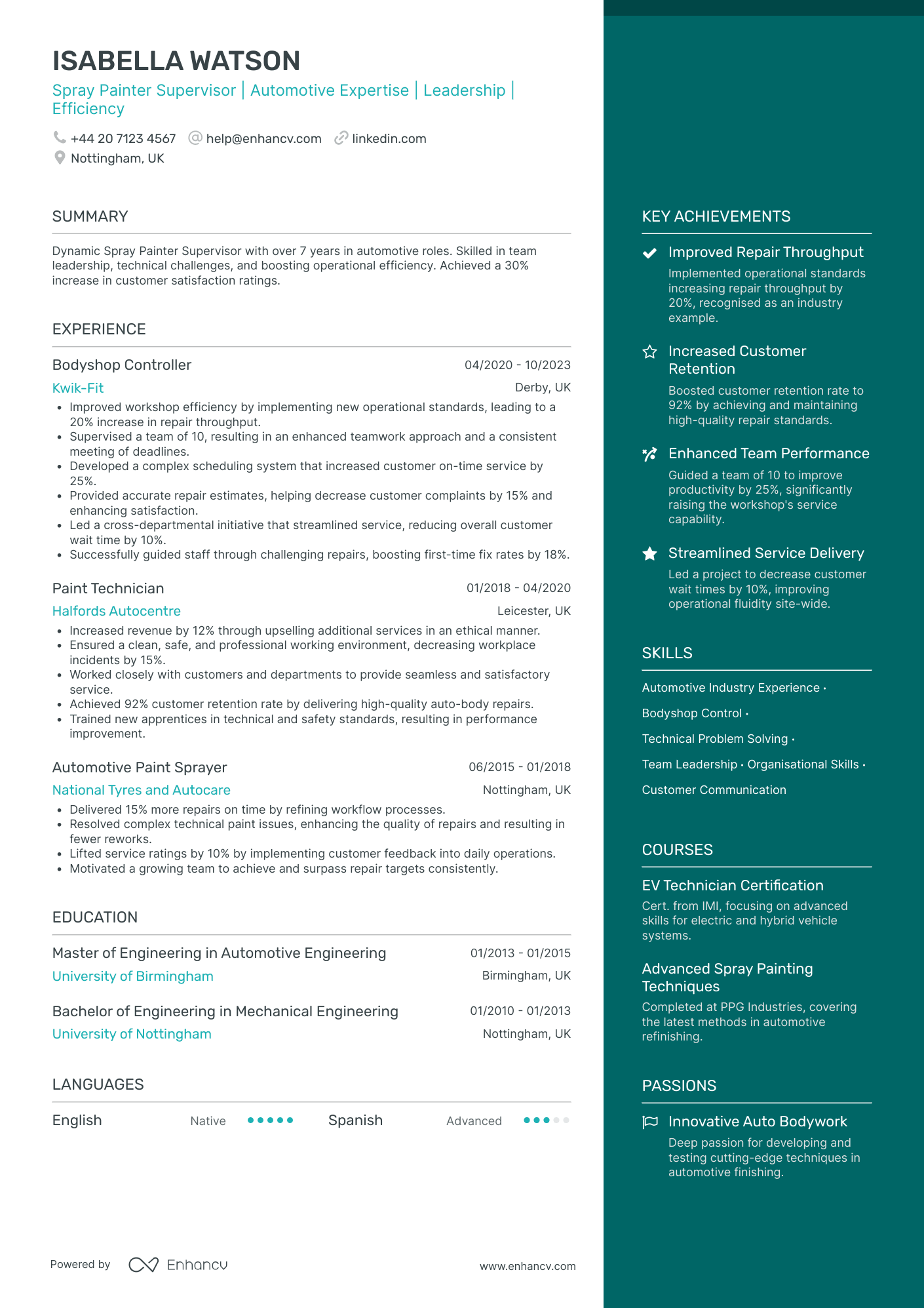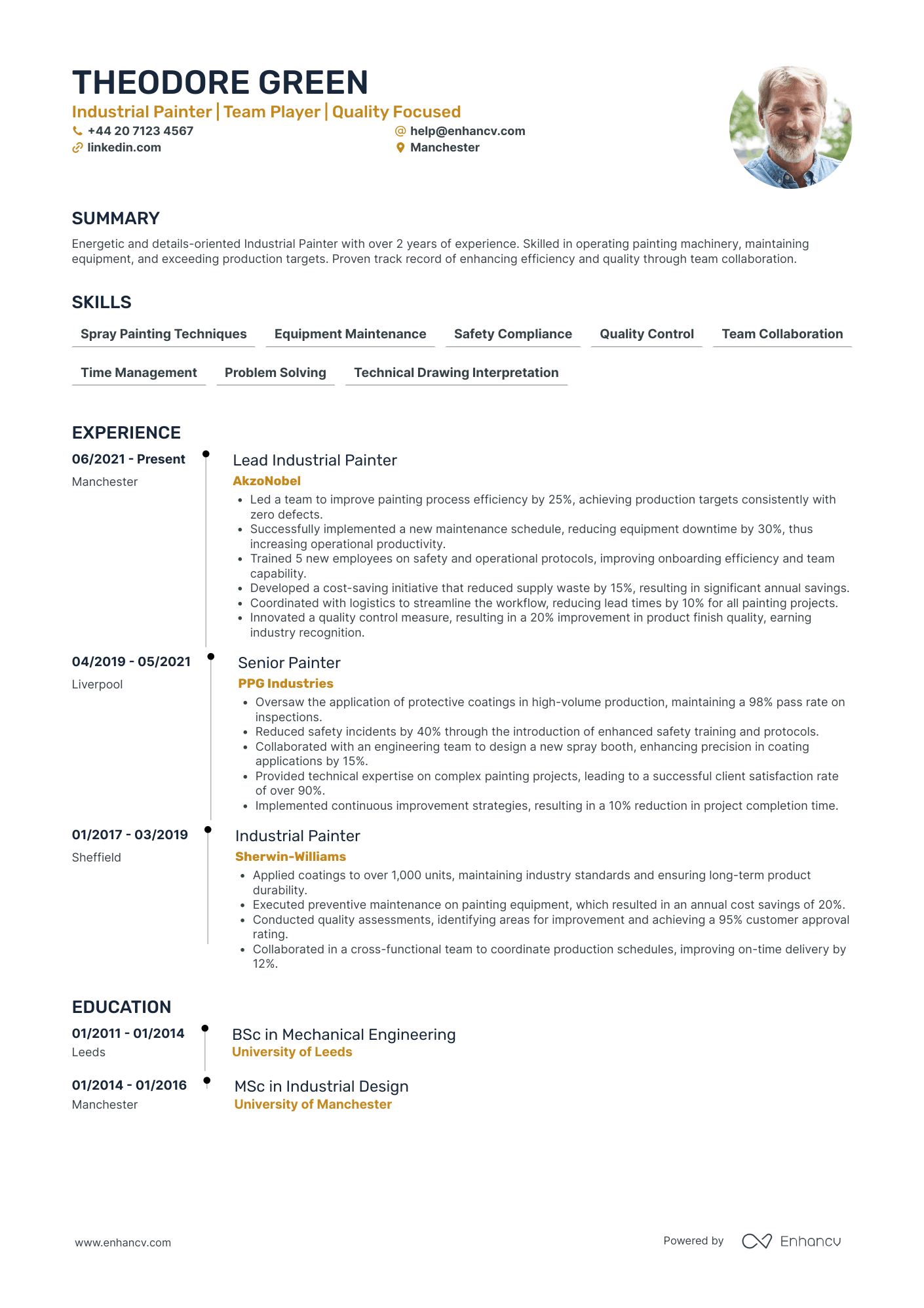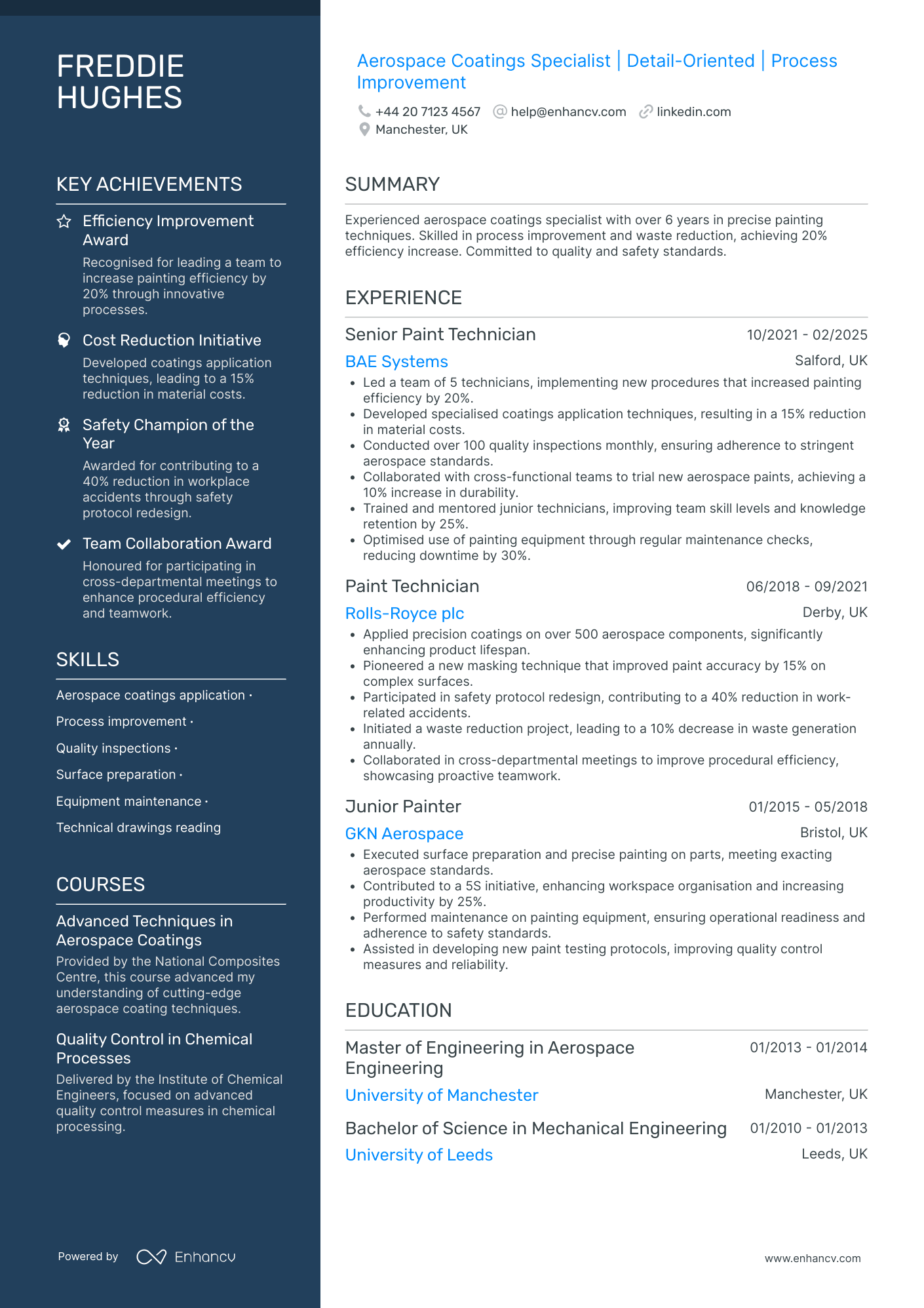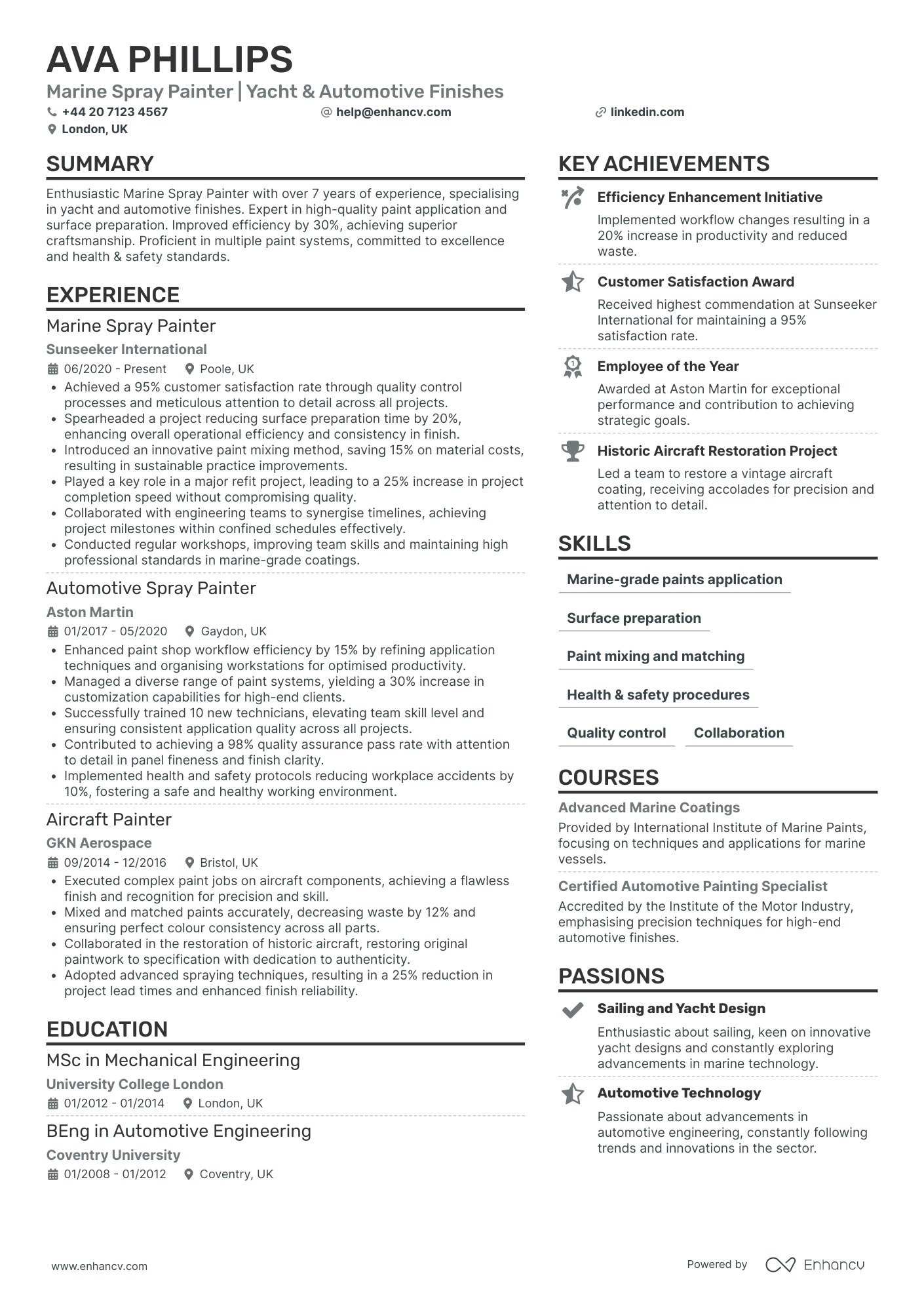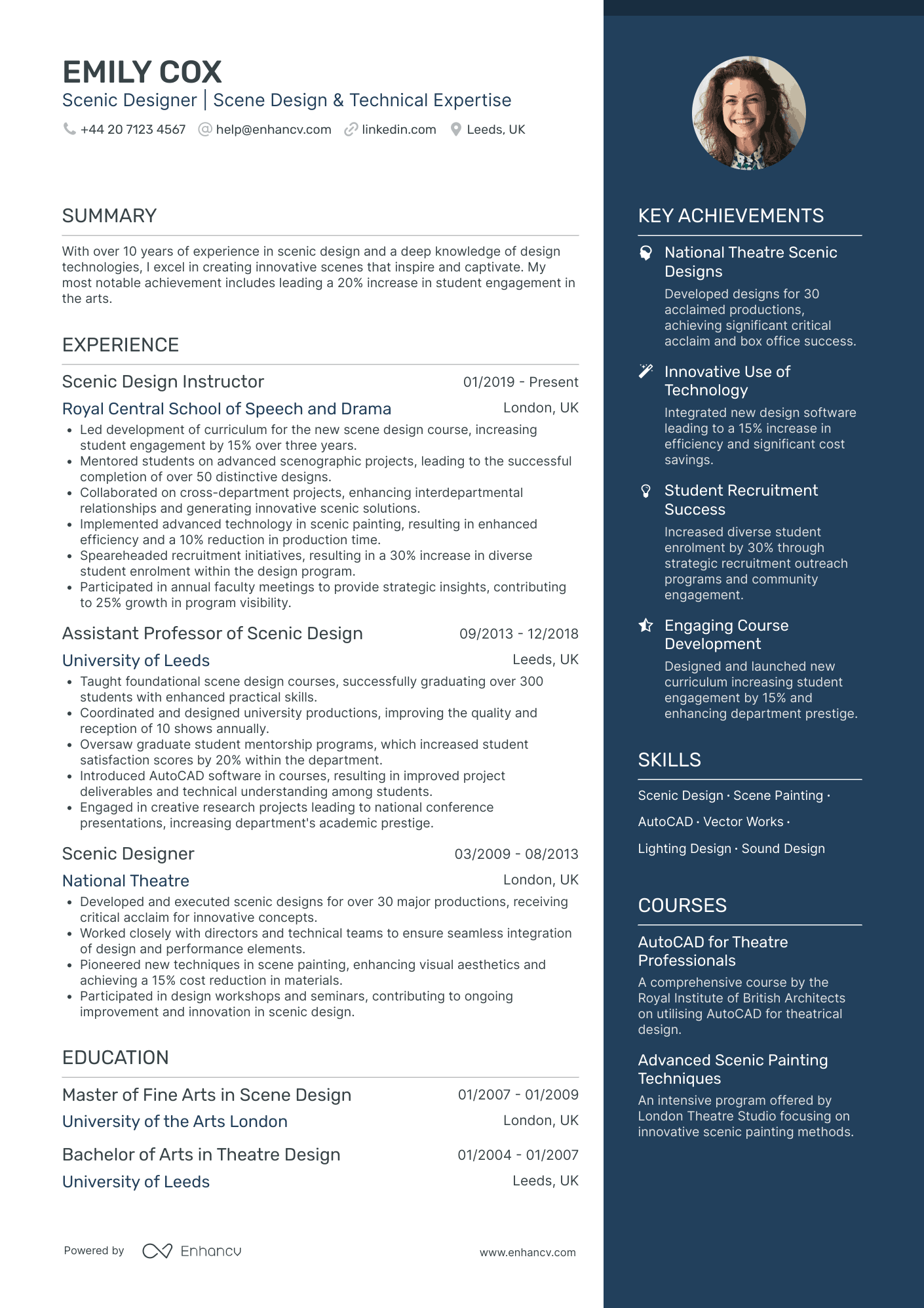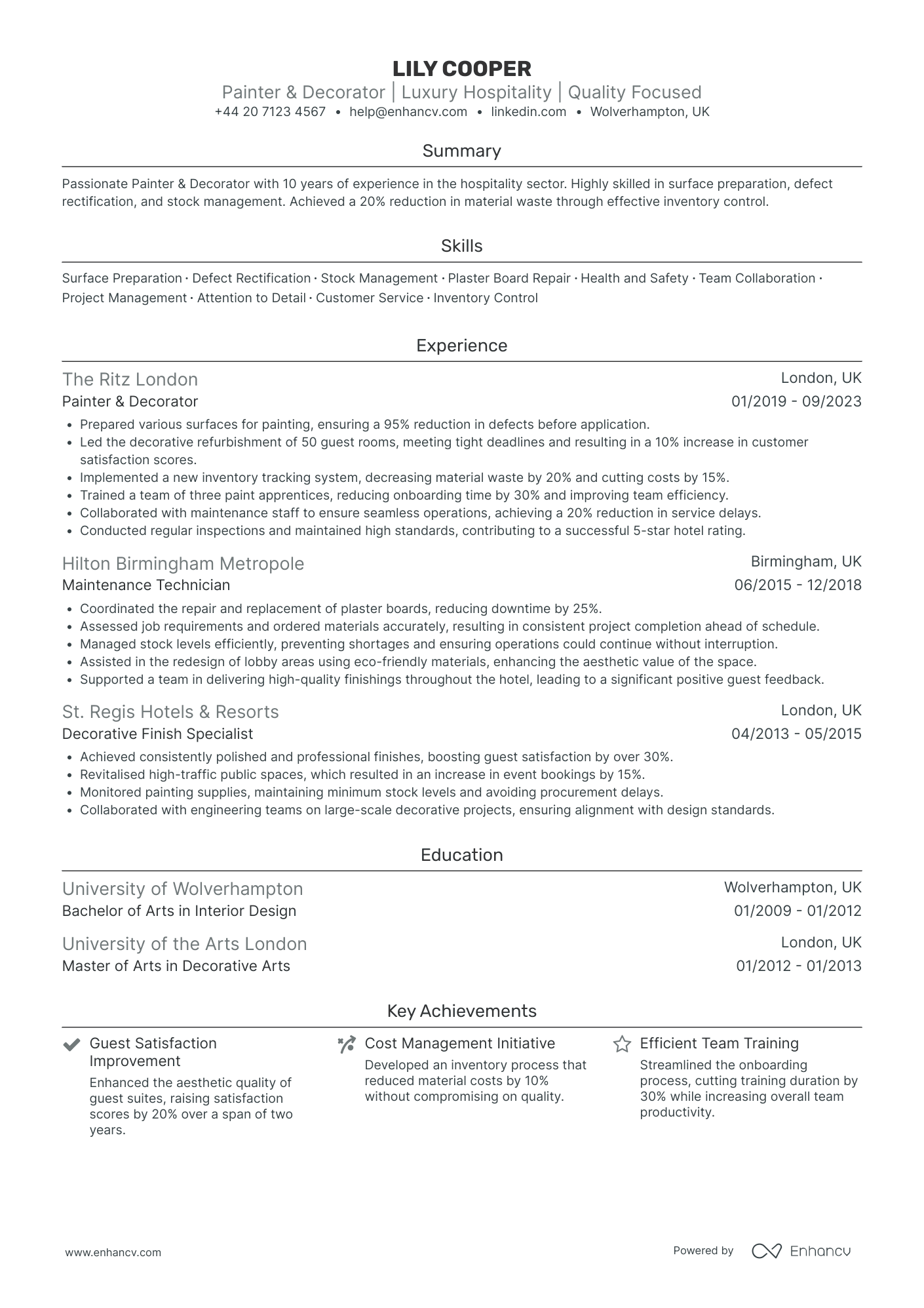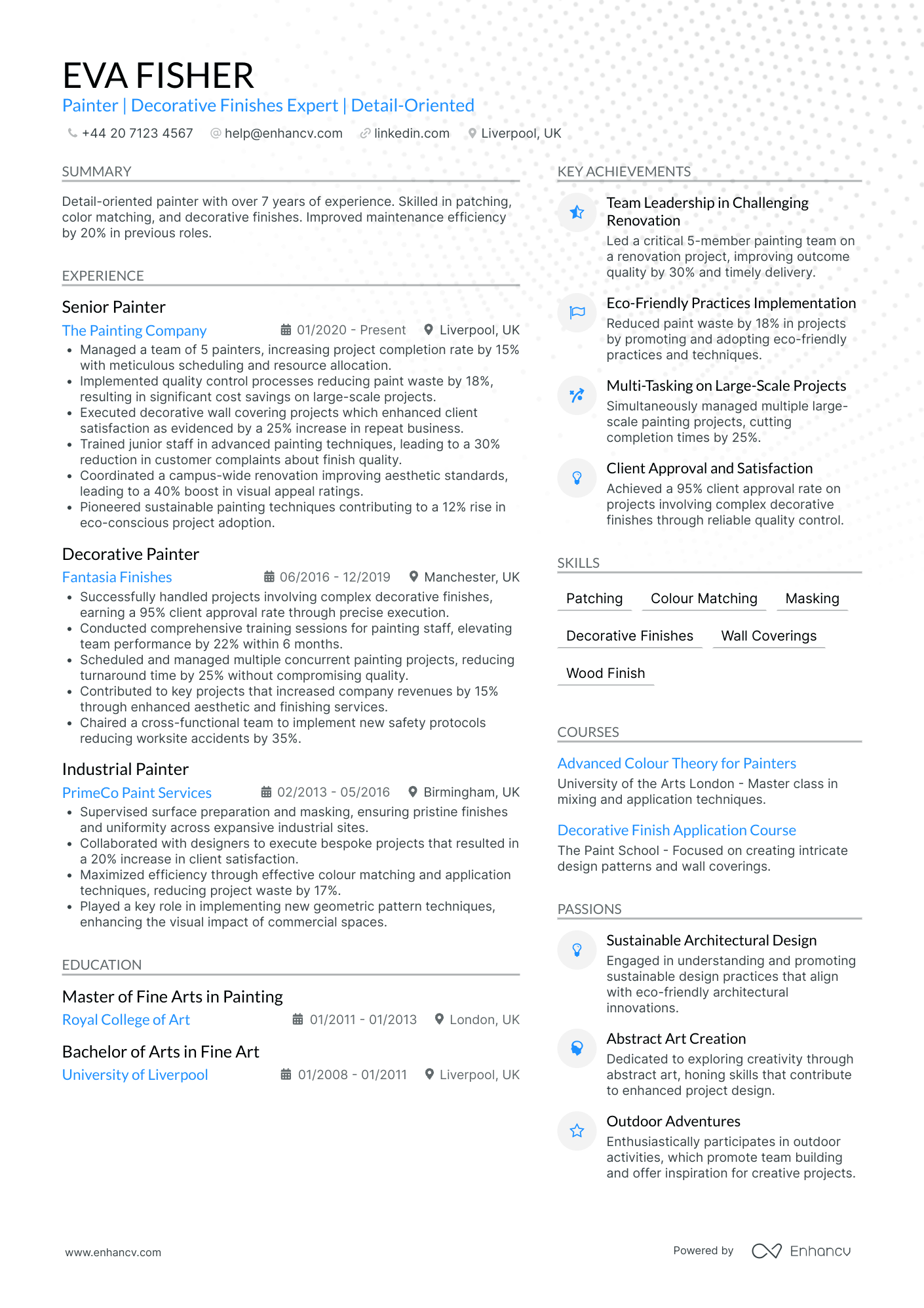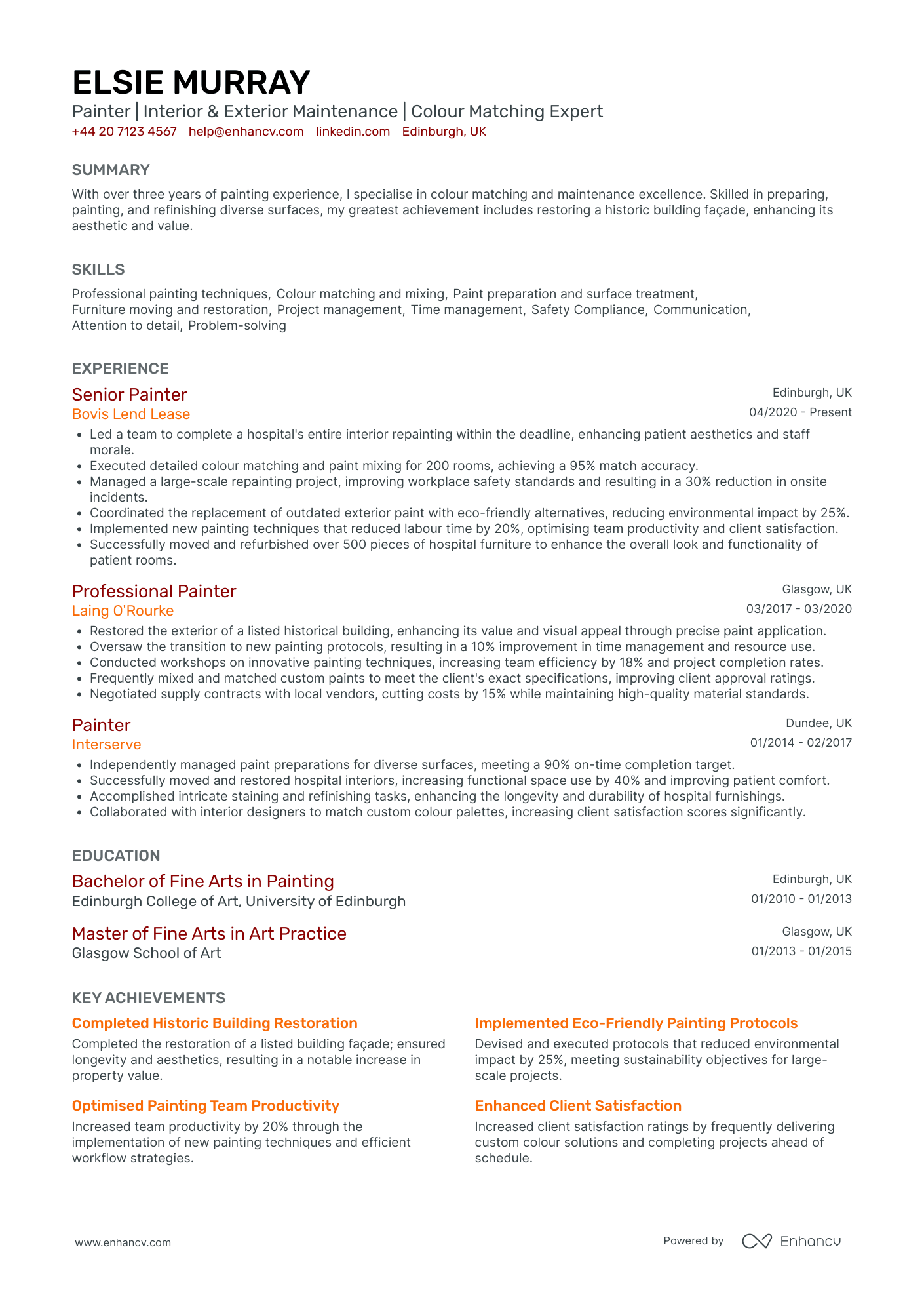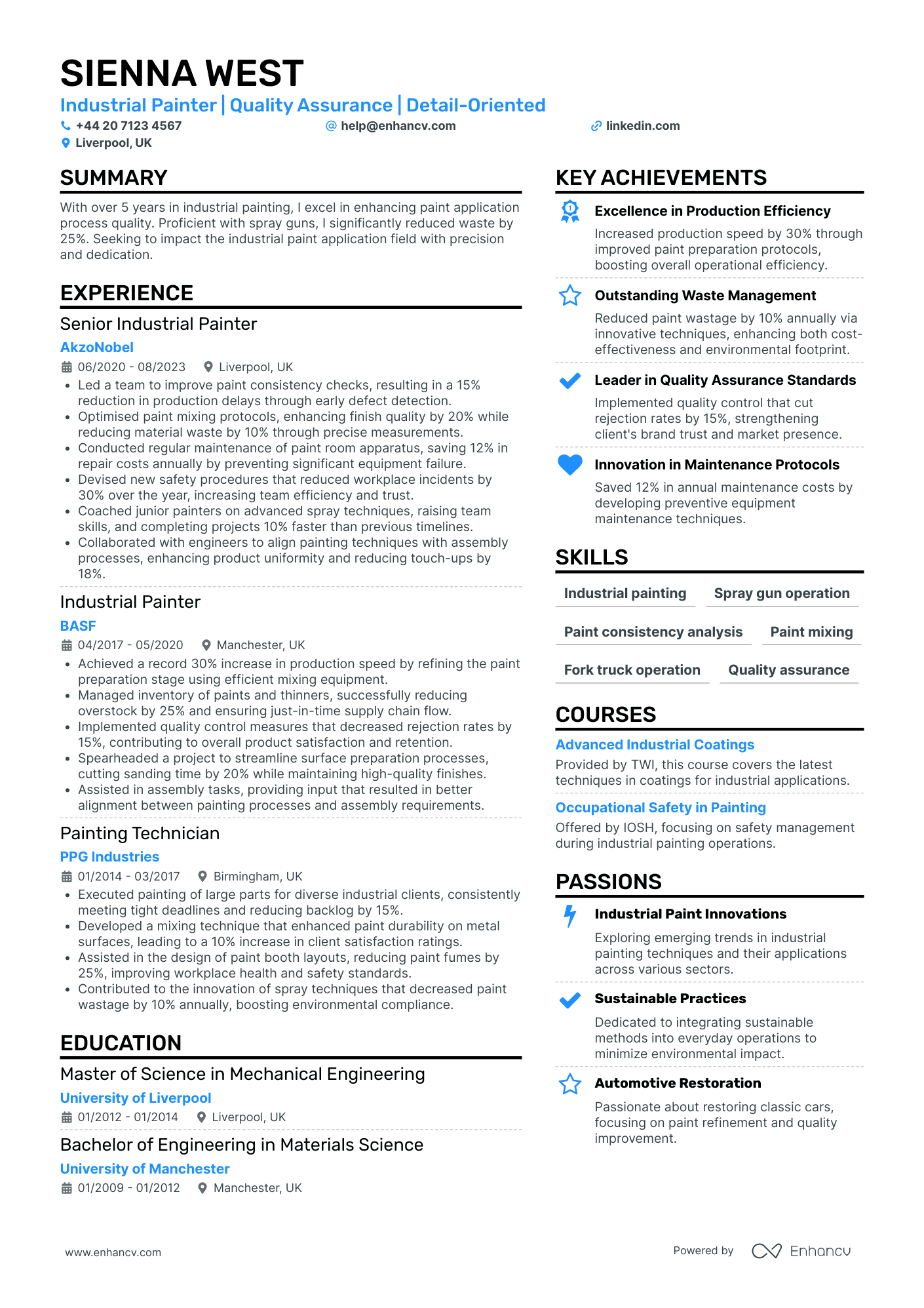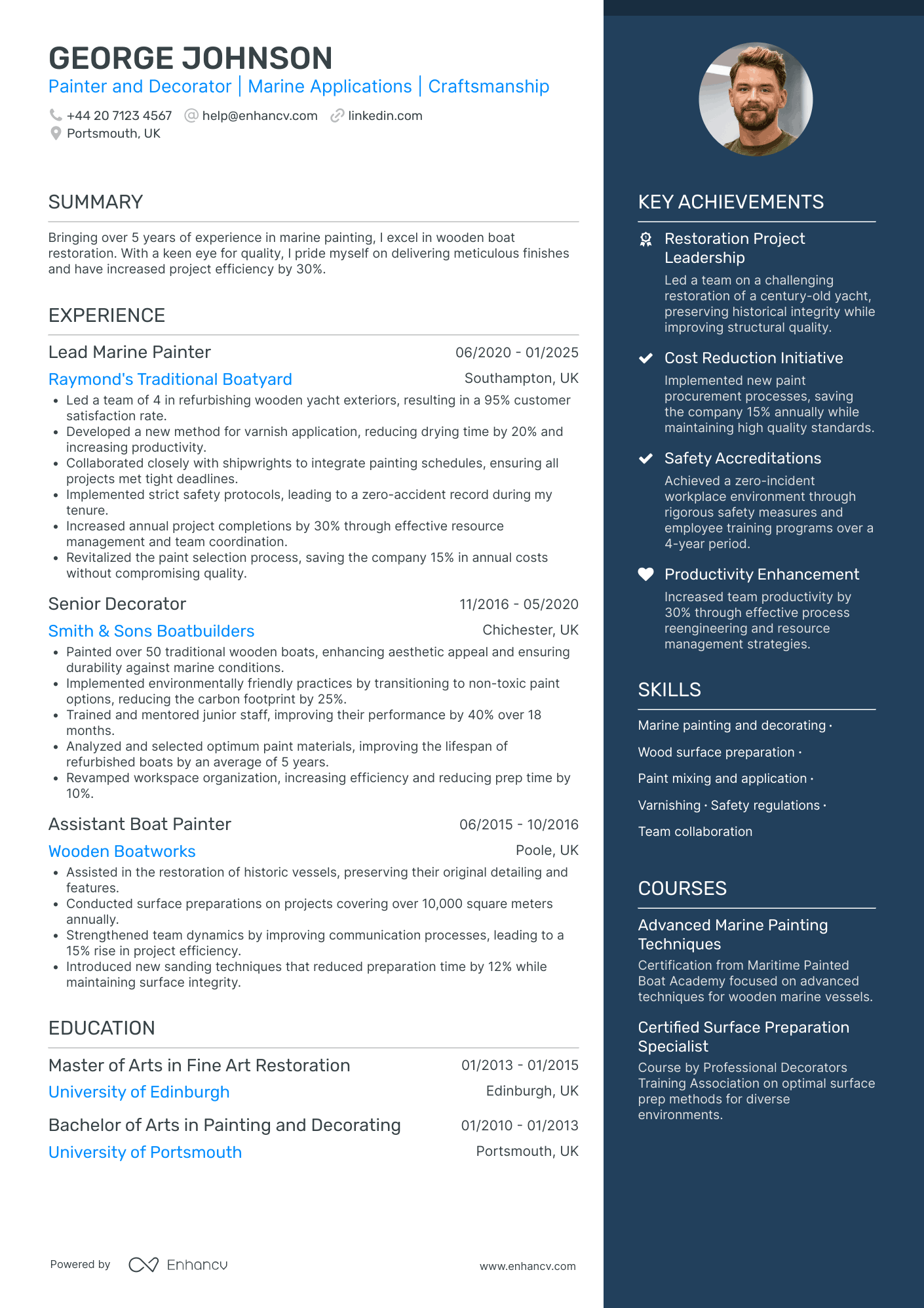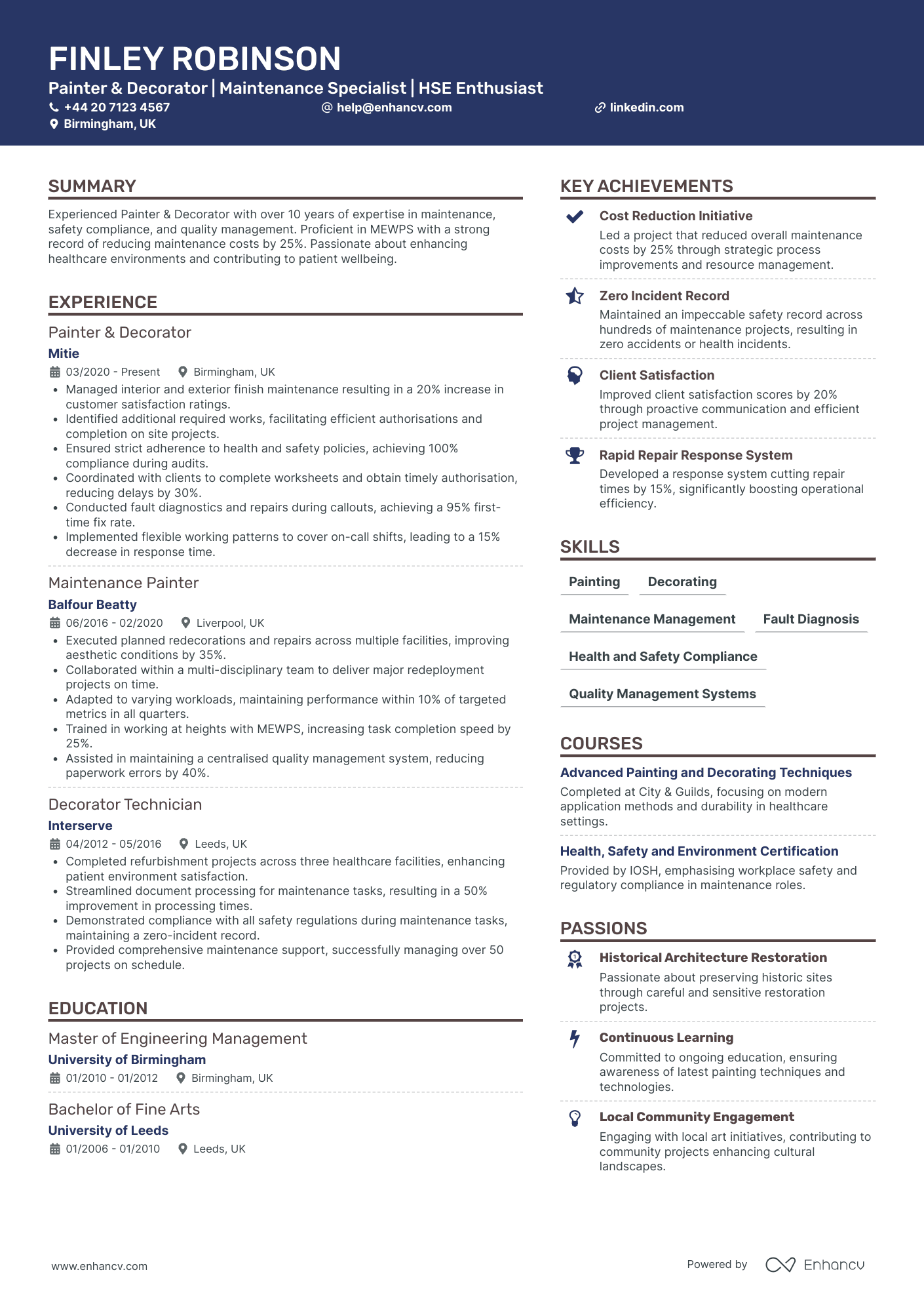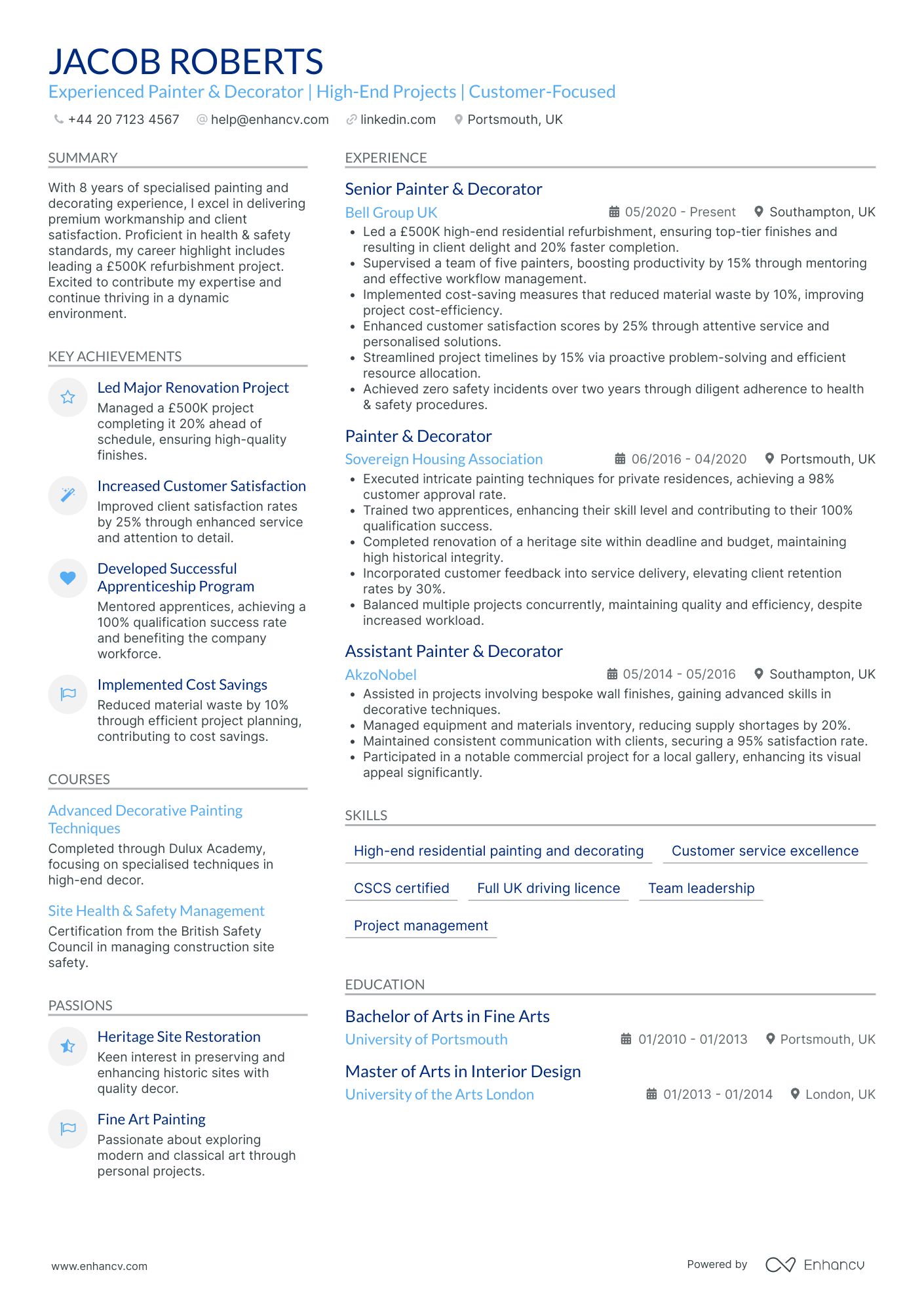One common CV challenge you might face as a painter is effectively showcasing your diverse range of artistic skills and projects. By consulting our guide, you'll learn how to construct a narrative that unifies your body of work and underscores your unique creative abilities.
- Create an attention-grabbing header that integrates keywords and includes all vital information;
- Add strong action verbs and skills in your experience section, and get inspired by real-world professionals;
- List your education and relevant certification to fill in the gaps in your career history;
- Integrate both hard and soft skills all through your CV.
Discover more industry-specific guides to help you apply for any role in the links below:
CV examples for painter
By Experience
Lead Painter
- Content Presentation Excellence - The CV is structured with clarity, utilizing distinct sections for education, experience, skills, and achievements that allow for easy navigation. Each bullet point within the sections is concise yet informative, effectively communicating the candidate's accomplishments and capabilities through clear and direct language.
- Career Trajectory and Growth - The CV outlines a clear career trajectory, showing Sophia Foster's progression from a Junior Painter to a Lead Facilities Painter, indicating a natural evolution in roles and responsibilities within the painting industry. This progression illustrates her growing expertise and leadership capabilities, as she moved from assisting projects to managing teams and streamlining processes.
- Unique Industry-Specific Proficiencies - Highlighting advanced painting techniques and efficient material management, Sophia’s CV delves into specialized methodologies that distinguish her technical depth, such as the reduction of primer use optimizing material waste and implementing a new scheduling system. These elements showcase her proficiency and innovation in the painting sector.
Junior Painter
- Structured Presentation for Easy Reading - Joshua's CV is neatly organized, starting with essential personal details, followed by a concise summary, work experience, education, skills, achievements, courses, languages, and passions. This structure provides a clear, holistic view of his professional profile, making it easy for potential employers to quickly grasp his qualifications and experience.
- Clear Career Progression and Growth - The CV illustrates a steady career trajectory from an intern at Jaguar Land Rover to a junior painter position at Airbus. This progression shows Joshua's competence and reliability in industrial painting, while his involvement in projects completed ahead of schedule reflects his capability to grow and contribute significantly to his workplace.
- Emphasis on Industry-Specific Skills and Achievements - Joshua highlights his expertise in areas such as industrial painting, paint mixing, and equipment operation, alongside achievements like reducing paint waste by 20% and ensuring zero safety incidents. These aspects demonstrate his technical depth and commitment to quality and safety in industrial settings, indicating his industry relevance.
Apprentice Painter
- Effective Content Presentation - The CV's structure is clear and logically organized, making it easy to navigate through the candidate's experience, skills, education, and achievements. Each section is concise yet detailed enough to give a comprehensive overview of Edward Mitchell’s qualifications, emphasizing his strengths in painting and decorating.
- Strong Career Progression - Edward Mitchell's career trajectory showcases significant growth and responsibility. Transitioning from a Painter to Senior Painter & Decorator, and eventually to Lead Painter & Decorator, indicates not only experience but a clear upward progression within the field, highlighting his leadership abilities and increased role scope over time.
- Achievements with Business Impact - The CV effectively showcases Mitchell’s accomplishments by linking them to business outcomes. For instance, the implementation of a new color consultation process and eco-friendly solutions didn't just improve project efficiency; they also enhanced client decision-making and increased client interest in sustainable options, illustrating his ability to drive forward-thinking initiatives in a traditionally hands-on industry.
Painter Supervisor
- Strong Career Progression - James Lewis' CV demonstrates a coherent career trajectory, showing a clear path from Painter to Paint Supervisor. This progression not only indicates his personal growth and increased responsibility but also reflects his dedication and growing expertise within the ship repair industry, solidifying his leadership capabilities.
- Unique Technical Prowess - The CV highlights specific industry-relevant skills such as coatings, hazardous materials management, and NACE certification. These elements showcase James' technical depth and specialized knowledge, making him an asset in ship repair and maintenance, particularly in safety and efficiency enhancements.
- Attention to Achievements and Results - The document comprehensively lists achievements that directly impact business outcomes, such as reducing workplace incidents by 30% and enhancing surface preparation techniques, which extend ship lifespans by 25%. This results-driven approach underscores his ability to deliver significant operational improvements and cost savings.
Painter Project Manager
- Comprehensive Career Growth - Charlie Thomas's CV showcases a robust career journey, moving from a Junior Painter to a Lead Painter. This progression highlights a strong commitment to professional development and mastery in the painting field, with significant roles in reputable companies across major cities in the UK and Ireland.
- Strategic Achievements with Business Impact - The CV highlights notable achievements such as increasing client satisfaction and positively impacting business revenue through meticulous project management and innovative strategies like inventory optimization, which demonstrates a clear understanding of how to align personal performance with overarching business goals.
- Advanced Technical Skills and Safety Compliance - Charlie's experience in implementing new painting techniques and safety protocols not only showcases their technical expertise but also their commitment to industry standards, safety, and sustainability, all of which are crucial in the home improvement and painting industry.
Senior Painter
- Structured Career Growth - Olivia's CV demonstrates a clear and progressive career trajectory, advancing from an Apprentice Painter to a Senior Painter. This growth indicates a strong capability to adapt to new roles and increased responsibilities, further highlighted by her transition into project management responsibilities.
- Industry-Specific Achievements - A notable feature of Olivia’s background is her combination of painting expertise and project management. Successfully leading projects up to the value of £200,000 and reducing project timelines by 30% showcase her ability to apply technical knowledge and project execution skills effectively.
- Robust Adaptability and Cross-Functional Collaboration - Olivia's ability to work across diverse sectors including residential, educational, and public buildings exemplifies her adaptability. Her experiences collaborating with contractors and engaging cross-functional teams ensure projects meet budgetary and timeline objectives, highlighting her proficiency in bridging diverse professional groups.
By Role
Residential House Painter
- Concise Presentation of Skills and Experience - The CV effectively condenses George Johnson's 13 years of industry experience into a structured and clear format, making it easy for potential employers to grasp his competencies at a glance. It emphasizes his expertise in painting and drywall, aligning well with the intended role.
- Notable Career Growth and Leadership Transition - From his role as a Residential Painter at Taylor Wimpey to becoming a Lead Residential Painter at Toll Brothers, George Johnson demonstrates a clear trajectory of increasing responsibilities and leadership. This progression highlights his ability to take on more complex projects and lead teams successfully.
- Proven Impact Through Detailed Achievements - The CV includes specifics on how Johnson's initiatives led to increased efficiency and client satisfaction, like reducing project completion times by 20% and improving client ratings by 30%. This demonstrates not just his technical skills but his ability to influence business outcomes positively.
Commercial Building Painter
- Clear Career Progression - The candidate demonstrates a clear upward trajectory from Painter to Senior Painter, showcasing a natural progression in their career. This growth is marked by significant responsibility increases, such as leading larger teams and managing more complex projects, indicating readiness for further leadership roles in the painting industry.
- Effective Team Leadership and Safety Standards - Isaac Scott’s leadership skills are highlighted through achievements like training junior painters and enhancing safety protocols that led to a reduction in on-site incidents by 25%. The focus on safety compliance and teamwork underlines their capability to manage teams effectively while ensuring project safety and efficiency.
- Significant Achievements with Business Impact - The CV lists substantial achievements such as implementing strategies that result in reduced material waste and improved client satisfaction. These accomplishments speak volumes about their capacity to contribute to business success through cost-saving measures and high client retention, demonstrating a strong understanding of business needs within their role.
Automotive Spray Painter
- Clear Structure and Conciseness - Isabella's CV is well-organized and easy to read, with distinct sections that clearly convey her experiences and skills. Each position listed includes specific achievements, making it simple for an employer to understand her impact and contributions quickly.
- Demonstrated Career Growth and Leadership - Over her career, Isabella has shown significant growth, moving from roles focused on technical execution to positions of leadership such as Spray Painter Supervisor. Her progression is clear and logical, illustrating her increasing responsibility and influence within the automotive industry, especially in team supervision and operational management.
- Unique Industry-Specific Methodologies - The CV highlights industry-specific achievements such as implementing new operational standards and refining workflow processes, which resulted in substantial improvements in repair throughput and first-time fix rates. These elements show her technical depth and understanding of automotive bodyshop operations.
Industrial Machinery Painter
- Comprehensive Presentation and Structure - Theodore Green's CV is exceptionally well-structured, leading with a concise summary that clearly outlines his industrial painting expertise. Each section is logically ordered, making it easy for readers to follow his career progression and key skills.
- Clear Advancement in Career Path - Theodore's career trajectory showcases a clear progression from an Industrial Painter to a Lead Industrial Painter. His roles at AkzoNobel and PPG Industries demonstrate growing responsibilities in leadership, efficiency improvement, and process optimization in the industrial painting field.
- Emphasis on Industry-Specific Skills and Tools - His proficiency in operating painting machinery and implementing maintenance schedules, combined with a strong focus on safety compliance, underscores his technical depth and specialized knowledge crucial for high-quality industrial painting.
Aerospace Equipment Painter
- Structured Presentation with Clear Progression - The CV is meticulously organized, presenting information in a logical order that highlights the candidate's progress from a Junior Painter to a Senior Paint Technician. Each section is concise yet detailed, making the document easy to navigate while providing a comprehensive overview of the candidate’s career path.
- Impressive Career Trajectory in a Specialized Field - Freddie Hughes demonstrates a consistent upward trajectory in a niche industry. Starting as a Junior Painter and advancing to a Senior Paint Technician role at notable companies like BAE Systems and Rolls-Royce, the CV showcases a steady climb in responsibilities and expertise within the aerospace coatings sector.
- Industry-Specific Expertise in Aerospace Coatings - The CV underscores unique technical skills and industry-specific methodologies, such as specialized coatings application techniques and cross-functional collaborations to trial new aerospace paints. This technical depth not only distinguishes Freddie as a subject matter expert but also indicates a robust understanding of the aerospace industry's coating processes.
Marine Vessel Painter
- Structured Progression and Industry Transition - Ava's career path showcases a remarkable evolution from working on aircraft coatings at GKN Aerospace to specializing in marine spray painting at Sunseeker International. This transition highlights her ability to adapt and excel across different industries, indicating a capacity for growth and versatility in her skill set.
- Mastery of Technical Depth in Coating Applications - The CV emphasizes Ava’s command of various paint systems for yachts, automobiles, and aircraft, a testament to her technical proficiency. Her experience with developing innovative paint mixing methods and advanced spraying techniques underscores her role as an expert in achieving high-quality finishes.
- Quantifiable Achievements Driving Business Impact - Ava’s accomplishments are clearly tied to business outcomes; she reduced surface preparation time by 20% and increased project completion speed by 25%, directly contributing to operational efficiency and customer satisfaction. These metrics highlight her ability to implement workflow improvements that have tangible benefits for employers.
Scenic Painter for Theatre
- Comprehensive and Clear Structure - The CV effectively organizes Emily Cox's extensive career information by segmenting it into distinct sections, starting from personal information to education and skills. This clarity in structure allows easy navigation and understanding of her qualifications, making the content concise and streamlined.
- Diverse Career Trajectory with Academic Contributions - Emily's career trajectory showcases significant growth from a Scenic Designer at the National Theatre to an educational role as a Scenic Design Instructor. Her transition into academia highlights her ability to share industry knowledge and contribute to the next generation of designers, reflecting both professional and educational accomplishments.
- Industry-Specific Technical Expertise - The CV highlights Emily's command over specialized tools like AutoCAD and Vector Works, demonstrating her technical acumen. This expertise underpins her capability to integrate advanced technology in her scenic designs, which is crucial in an industry that continually evolves with technological advancements.
Motion Picture Set Painter
- Consistent Career Progression in Luxury Hospitality - The CV portrays a clear career trajectory through luxury hospitality venues, showcasing growth from a Decorative Finish Specialist to a Painter & Decorator. This demonstrates the candidate's focus and commitment to high-end service environments, where attention to detail and quality are paramount.
- Comprehensive Skill Set with a Technical Edge - This CV highlights a deep technical proficiency in surface preparation and defect rectification, critical skills for maintaining the aesthetic standards of luxury hotels. Furthermore, courses in advanced decorative techniques and health and safety emphasize a commitment to professional development and adherence to industry standards.
- Impactful Achievements with Quantifiable Outcomes - The achievements section stands out by translating efforts into business-relevant improvements, such as a 20% reduction in material waste through inventory control and a boost in guest satisfaction scores by 10%. These metrics emphasize an ability to not only develop but effectively implement processes that drive tangible results.
Fine Art Painter
- Structured Clarity and Conciseness - The CV's presentation is impressive, with well-structured sections that ensure clarity and ease of reading. Bullet points within the experience section efficiently convey key responsibilities and achievements, allowing for a quick grasp of Eva Fisher's contributions and expertise in a few sentences.
- Leadership and Mentoring Abilities - Eva Fisher's roles reflect strong leadership skills, where she has managed and trained teams, exemplified by her achievements in improving team performance and reducing customer complaints. Her ability to influence and enhance her team's capabilities stands out, proving her effective mentorship.
- Effective Emphasis on Achievements and Business Impact - The CV effectively links achievements to business outcomes, showcasing how Eva's initiatives led to increased client satisfaction, cost savings, and improved project outcomes. This not only highlights her role in operational efficiency but also emphasizes the significant impact on business success.
Mural Painter
- Clear Path of Professional Growth - Elsie Murray's career trajectory reflects a steady rise in responsibility and expertise, evolving from an initial painter position to a senior role. This progression indicates reliability and value addition with each role, showcasing her ability to adapt and excel over time within the painting and maintenance industry.
- Strong Focus on Environmental Sustainability - Her CV uniquely highlights a commitment to eco-friendly practices, an underrated yet pivotal element in modern maintenance work. Elsie's involvement in replacing outdated paints with eco-friendly alternatives and creating sustainable painting protocols underlines a forward-thinking approach that resonates with businesses aiming to meet sustainability goals.
- Comprehensive Skillset with Leadership Abilities - The CV presents a blend of technical painting skills and leadership experiences, illustrating Elsie's capability beyond painting tasks. She has a proven record in project management, enhancing team productivity, and improving workplace safety, demonstrating preparedness to lead teams in achieving high-quality outcomes efficiently.
Faux Finish Painter
- Structured Career Growth and Aspirations - Sienna West’s career trajectory is meticulously narrated, highlighting a steady progression from a Painting Technician to a Senior Industrial Painter. This linear growth is complemented by her commitment to the field, as evidenced by completed industry-relevant courses and a Master’s degree in Mechanical Engineering, indicating both experience and formal education in her domain.
- Comprehensive Technical Expertise - West's proficiency with specific tools and techniques, such as spray gun operation and paint consistency analysis, stands out. Her ability to tailor and innovate methodologies to improve efficiency and quality reflects a deep technical expertise uncommon in standard presentations, adding significant value to her roles.
- Leadership and Team Development - West exhibits significant leadership skills, demonstrated by her ability to reduce workplace incidents and mentor junior painters, improving performance and efficiency by 10%. Her approach to safety and fostering a collaborative environment augments her technical acumen, showcasing her as a well-rounded professional who influences her team beyond technical know-how.
Historical Restoration Painter
- Structured Career Path - George Johnson's CV illustrates a clear and deliberate career progression within the marine painting and decorating industry. From an Assistant Boat Painter to a Lead Marine Painter, each role builds logically on the previous, demonstrating a consistent focus on advancing his technical and leadership skills.
- Implementation of Innovative Techniques - This CV stands out by showcasing unique methods and industry-specific techniques, such as the development of a new varnish application that reduced drying time. These innovations not only indicate George's technical prowess but also his ability to drive efficiency and improve quality standards.
- Highlighting Leadership and Safety - Emphasizing leadership qualities, George has a proven record of increasing project efficiency and maintaining safety standards. His creation of strict safety protocols and achieving a zero-accident record demonstrate his commitment to creating a secure working environment, a crucial aspect in marine applications.
Painter and Decorator
- Structured and Accessible Content - The CV is organized logically, with a clear separation of sections such as experience, education, skills, and achievements, making it easy to navigate. Each section is concise yet comprehensive, providing enough detail to understand Finley's qualifications without overwhelming the reader.
- Progressive Career Path - Finley Robinson's career trajectory shows consistent growth and increased responsibility, from a Decorator Technician to a Painter & Decorator. The progression highlights his ability to take on more complex roles and adapt to changing industry demands, while maintaining a focus on health and safety and efficiency improvement.
- Specialized Tools and Techniques - The inclusion of specialized tools like MEWPS and industry-specific methodologies such as quality management systems demonstrates Finley's technical proficiency and readiness to tackle demanding painting and maintenance tasks. Such technical depth is vital in ensuring the safety and effectiveness of their work.
Freelance Painter
- Efficient Content Structuring - The CV is meticulously organized with clear headers and succinct bullet points, demonstrating the candidate’s ability to communicate complex career details in a straightforward manner. This clarity ensures that important accomplishments and experience are immediately accessible, reflecting a keen attention to detail that is crucial in the painting and decorating industry.
- Diverse Career Progression - Jacob’s career trajectory shows a clear path of progression from an assistant painter to a senior role, highlighting significant growth both in terms of responsibility and skill. His movement between different companies reflects adaptability and a dedication to advancing within the industry, all while acquiring a deep technical and leadership skill set.
- Impactful Project Achievements - The CV is heavily loaded with achievements that go beyond mere completion of tasks, emphasizing the impact on business outcomes. For instance, leading a £500K refurbishment project ahead of schedule and implementing cost-saving measures exemplifies how Jacob contributes to business efficiency, client satisfaction, and reputation enhancement within the high-end residential sector.
How to ensure your profile stands out with your painter CV format
It's sort of a Catch 22. You want your painter CV to stand out amongst a pile of candidate profiles, yet you don't want it to be too over the top that it's unreadable. Where is the perfect balance between your CV format simple, while using it to shift the focus to what matters most. That is - your expertise. When creating your painter CV:
- list your experience in the reverse chronological order - starting with your latest roles;
- include a header with your professional contact information and - optionally - your photograph;
- organise vital and relevant CV sections - e.g. your experience, skills, summary/ objective, education - closer to the top;
- use no more than two pages to illustrate your professional expertise;
- format your information using plenty of white space and standard (2.54 cm) margins, with colours to accent key information.
Once you've completed your information, export your painter CV in PDF, as this format is more likely to stay intact when read by the Applicant Tracker System or the ATS. A few words of advice about the ATS - or the software used to assess your profile:
- Generic fonts, e.g. Arial and Times New Roman, are ATS-compliant, yet many candidates stick with these safe choices. Ensure your CV stands out by using a more modern, and simple, fonts like Lato, Exo 2, Volkhov;
- All serif and sans-serif fonts are ATS-friendly. Avoid the likes of fancy decorative or script typography, as this may render your information to be illegible;
- Both single- and double-column formatted CVs could be assessed by the ATS;
- Integrating simple infographics, icons, and charts across your CV won't hurt your chances during the ATS assessment.

PRO TIP
For certain fields, consider including infographics or visual elements to represent skills or achievements, but ensure they are simple, professional, and enhance rather than clutter the information.

The top sections on a painter CV
- Personal Statement outlines the painter's artistic philosophy and career goals, providing a personal touch to the CV.
- Professional Experience showcases the painter's previous relevant work, highlighting skills and achievements in the field.
- Artistic Achievements list awards, exhibitions, and recognitions, offering credibility and status in the art community.
- Relevant Education details formal training and courses, showing a foundation of artistic knowledge and technique.
- Technical Skills and Mediums illustrate the painter's proficiency in various styles and materials, demonstrating versatility.

What recruiters value on your CV:
- Highlight your artistic style and medium specialisation, mentioning key themes or subjects in your works and the materials you commonly use, as this demonstrates your expertise and unique brand as a painter.
- Include a portfolio link or mention exhibitions you've participated in, since a visual showcase of your art is critical to highlight your talent and experience in the field.
- Detail any art-related education or training you have undergone, such as fine arts degrees or specific workshops, which can underscore your technical skills and theoretical knowledge.
- Mention collaborations or projects with galleries, museums, or other artists, as this exhibits your ability to work professionally within the arts community and your network within the industry.
- Outline any relevant awards or recognitions you have received, because accolades from reputable sources can add credibility and prestige to your CV, setting you apart from other candidates.
Recommended reads:
Tips and tricks on writing a job-winning painter CV header
The CV header is the space which most recruiters would be referring most often to, in the beginning and end of your application. That is as the CV header includes your contact details, but also a headline and a professional photo. When writing your CV header:
- Double-check your contact details for spelling errors or if you've missed any digits. Also, ensure you've provided your personal details, and not your current work email or telephone number;
- Include your location in the form of the city and country you live in. If you want to be more detailed, you can list your full address to show proximity to your potential work place;
- Don't include your CV photo, if you're applying for roles in the UK or US, as this may bias initial recruiters' assessments;
- Write a professional headline that either integrates the job title, some relevant industry keywords, or your most noteworthy achievement.
In the next part of our guide, we'll provide you with professional CVs that showcase some of the best practices when it comes to writing your headline.

Examples of good CV headlines for painter:
- Lead Mural Artist | Site-Specific Installations | Fine Arts Degree | 10+ Years of Creative Excellence
- Gallery Exhibited Painter | Abstract & Realism | BA Hons Fine Art | Professional Artist since 2015
- Residential Decorative Painter | Faux Finishing Specialist | NVQ Level 3 | 5 Years Trade Expertise
- Conceptual Art Creator | Mixed Media Expert | MA Visual Arts | Rising Talent in Contemporary Art
- Commissioned Portrait Painter | Classical Techniques | BTEC Diploma | Client-Focused with 8 Years' Experience
- Public Art Project Lead | Environmental Art Innovator | MFA Grad | 12 Years Evolving Public Spaces
Choosing your opening statement: a painter CV summary or objective
At the top one third of your CV, you have the chance to make a more personable impression on recruiters by selecting between:
- Summary - or those three to five sentences that you use to show your greatest achievements. Use the CV summary if you happen to have plenty of relevant experience and wish to highlight your greatest successes;
- Objective - provides you with up to five sentences to state your professional aims and mission in the company you're applying for

CV summaries for a painter job:
- With over 10 years of experience as a professional painter, specialising in landscape and portrait artwork with a strong command over oil and watercolour mediums. Biggest career milestone was being commissioned for an exclusive gallery exhibition in London that garnered significant attention within the art community.
- Seasoned artist with 15 years in graphic design now transitioning to canvas painting, bringing a wealth of composition techniques and a keen eye for detail. Proven ability in digital art creation, now seeking to apply these strengths to traditional painting methods.
- Creative illustrator with a decade in the digital advertising industry, now pivoting to focus on fine arts painting. Proficient in using a variety of textures and materials to create visually compelling images. A strong portfolio with high-profile client commissions, aspiring to explore the realms of abstract painting.
- Highly skilled painter with 8 years’ experience, exceptional proficiency in acrylics and pastels, and a thorough understanding of art history. A standout accomplishment includes a series of murals created for a major city regeneration project in Manchester.
- As a budding artist with zeal for learning, my objective is to harness my foundation in sketching and passion for visual storytelling to develop as a painter. Though new to the field, my dedication is mirrored by a comprehensive knowledge of art theory and practical application garnered through intensive self-study.
- Determined to embark on a journey as a painter, I aim to bring fresh perspectives through the interpretation of modern life onto canvas. With no prior professional experience but a resolute commitment to mastering various painting techniques, my goal is to contribute a unique voice to contemporary art discussions.
The best formula for your painter CV experience section
The CV experience section is the space where many candidates go wrong by merely listing their work history and duties. Don't do that. Instead, use the job description to better understand what matters most for the role and integrate these keywords across your CV. Thus, you should focus on:
- showcasing your accomplishments to hint that you're results-oriented;
- highlighting your skill set by integrating job keywords, technologies, and transferrable skills in your experience bullets;
- listing your roles in reverse chronological order, starting with the latest and most senior, to hint at how you have grown your career;
- featuring metrics, in the form of percentage, numbers, etc. to make your success more tangible.
When writing each experience bullet, start with a strong, actionable verb, then follow it up with a skill, accomplishment, or metric. Use these professional examples to perfect your CV experience section:

Best practices for your CV's work experience section
- Delivered high-quality residential and commercial painting services, consistently meeting client specifications and completing projects on schedule over a five-year period.
- Expertly matched colours and mixed paints to client satisfaction, reducing waste and ensuring cost-effective use of materials through precision mixing techniques.
- Prepared surfaces by cleaning, repairing cracks, and sanding, ensuring a flawless finish and adherence to strict industry standards for over 50 projects.
- Operated various painting equipment, such as sprayers and brushes, with skill and attention to detail, contributing to the team's reputation for excellence.
- Implemented effective safety protocols, resulting in a zero-accident record while conducting interior and exterior painting tasks at heights.
- Coordinated with other tradespeople and team members to ensure seamless project execution, effectively avoiding delays and disruptions on complex work sites.
- Managed inventory and procurement of painting supplies, demonstrating keen organisational skills and minimising project costs by 10% through strategic planning.
- Provided exceptional customer service, garnering repeat business and client referrals by going above and beyond with after-service follow-ups and touch-ups.
- Stayed up-to-date with the latest painting techniques and trends, attending workshops and training sessions, further enhancing the quality of work provided to clients.
- Supervised a team of 10 painters, ensuring high standards on paint finishes on major commercial buildings and managed project schedules to ensure timely completion.
- Developed a new color-matching technique that improved the accuracy of matches by 30%, substantially reducing waste and costs associated with rework.
- Directly negotiated with suppliers, leading to a 15% reduction in paint supply costs while maintaining quality, improving the department's overall profitability.
- Specialized in high-end residential painting, consistently delivering projects that exceeded homeowners' expectations and receiving a 95% satisfaction rate through client feedback.
- Introduced an eco-friendly painting option to our services, resulting in a 25% increase in business from environmentally-conscious homeowners.
- Led the development and execution of a custom mural project for a luxury estate, which became a showcase piece in our portfolio and resulted in significant media exposure.
- Oversaw the exterior and interior painting of commercial properties, including a landmark 50-story skyscraper, ensuring compliance with all safety regulations.
- Implemented a digital job tracking system which reduced project reporting times by 40%, enhancing overall operational efficiency.
- Coordinated with other trades on large-scale construction sites to ensure seamless integration of painting work with other project phases, mitigating delays.
- Applied specialized coating systems on industrial machinery, contributing to an extension of the equipment lifespan by up to 50% over previous coating solutions.
- Streamlined surface preparation processes, increasing the throughput by 20% while maintaining adherence to stringent quality control measures.
- Participated in the research and development of a heat-resistant paint formula, subsequently adopted for use in high-temperature manufacturing environments.
- Executed custom paint jobs including graphics and airbrush art, contributing to a 10% increase in custom services revenue for the auto shop.
- Pioneered the use of a new UV protective sealant that significantly reduced fading and chipping in car finishes exposed to extreme weather conditions.
- Collaborated closely with clients to bring their vision for their vehicles to life, leading to the production of award-winning show cars.
- Mastered fundamental painting and decorating techniques while assisting on various residential and commercial projects under the tutelage of experienced professionals.
- Received commendations for precision and attention to detail in preparing surfaces and applying finishes, laying the groundwork for a successful painting career.
- Contributed to a major renovation project that won regional awards for best commercial refurbishment, gaining significant hands-on experience in the field.
- Advanced the company's offerings with unique faux finish techniques that mimicked natural materials like marble and wood, creating a niche service that grew by 200% during tenure.
- Conducted workshops for fellow painters, sharing expertise in decorative finishes and fostering a culture of continuous learning and skill enhancement.
- Provided bespoke wall treatments for over 50 individual clients, many of whom became repeat customers, affirming the value of personalized service in our industry.
- Improved the team's project completion rate by 35% through strategic planning and effective delegation of tasks for residential and commercial exterior painting projects.
- Led quality assurance efforts that reduced customer callbacks for touch-ups and repairs by 20%, significantly enhancing the company's reputation for quality workmanship.
- Expertly managed logistical challenges associated with seasonal weather changes, ensuring that paint applications were optimized for longevity and aesthetic appeal.
- Conceptualized and executed large-scale murals for public and private spaces which have become local landmarks and have strengthened community engagement with art.
- Negotiated contracts and conceptual design initiatives with city officials and stakeholders for beautification projects, contributing to urban renewal efforts.
- Sourced environmentally sustainable materials for art installations, decreasing the environmental impact of projects by 40% compared to traditional materials.
- Managed a large-scale paint shop operation, overseeing 25 staff members and delivering top-quality finishes for a wide array of products, resulting in a customer return rate of over 90%.
- Instituted a continuous improvement policy that saw a year-over-year increase in productivity by 15% while simultaneously cutting down on waste by 25%.
- Collaborated with engineering and design teams to enhance paint system efficiencies, ultimately reducing project lead times by an average of 10 days.
Writing your CV without professional experience for your first job or when switching industries
There comes a day, when applying for a job, you happen to have no relevant experience, whatsoever. Yet, you're keen on putting your name in the hat. What should you do? Candidates who part-time experience , internships, and volunteer work.
Recommended reads:

PRO TIP
If applicable, briefly mention a situation where things didn’t go as planned and what you learned from it, demonstrating your ability to learn and adapt.
The CV skills' divide: between hard and soft skills
Of course, you may have read the job requirements plenty of times now, but it's key to note that there is a difference between technical and personal skills. Both are equally relevant to your job application. When writing about your skill set, ensure you've copy-pasted the precise skill from the job requirement. This would not only help you ensure you have the correct spelling, but also pass any Applicant Tracker System (ATS) assessments.
- Hard skills show your technological capabilities. Or whether you'll be a good technical fit to the organisation. Ensure you've spotlighted your hard skills in various sections of your CV (e.g. skills section, projects, experience) by including the technology and what you've attained;
- Soft skills pinpoint your personality and people or communication skills, hinting at if you'll easily accomodate into the team or organisation. Quantify your soft skills in your CV achievements, strengths, summary/objective, and experience sections. Always support your soft skills with how they've helped you grow as a professional.
Top skills for your painter CV:
Surface Preparation
Colour Mixing
Paint Application Techniques
Spraying Equipment Proficiency
Understanding of Paint Composition
Wallpapering
Attention to Detail
Safety and Compliance
Equipment Maintenance
Basic Maths for Measurements
Creativity
Time Management
Customer Service
Problem-Solving
Flexibility
Teamwork
Reliability
Patience
Physical Stamina
Communication

PRO TIP
Order your skills based on the relevance to the role you're applying for, ensuring the most pertinent skills catch the employer's attention first.
Further professional qualifications for your painter CV: education and certificates
As you're nearing the end of your painter CV, you may wonder what else will be relevant to the role. Recruiters are keen on understanding your academic background, as it teaches you an array of hard and soft skills. Create a dedicated education section that lists your:
- applicable higher education diplomas or ones that are at a postgraduate level;
- diploma, followed up with your higher education institution and start-graduation dates;
- extracurricular activities and honours, only if you deem that recruiters will find them impressive.
Follow a similar logic when presenting your certificates. Always select ones that will support your niche expertise and hint at what it's like to work with you. Balance both technical certification with soft skills courses to answer job requirements and company values. Wondering what the most sought out certificates are for the industry? Look no further:

PRO TIP
If there's a noticeable gap in your skillset for the role you're applying for, mention any steps you're taking to acquire these skills, such as online courses or self-study.
Recommended reads:
Key takeaways
Impressing recruiters with your experience, skill set, and values starts with your professional painter CV. Write concisely and always aim to answer job requirements with what you've achieved; furthermore:
- Select a simple design that complements your experience and ensures your profile is presentable;
- Include an opening statement that either spotlights your key achievements (summary) or showcases your career ambitions (objective);
- Curate your experience bullets, so that each one commences with a strong, action verb and is followed up by your skill and accomplishment;
- List your hard and soft skills all across different sections of your CV to ensure your application meets the requirements;
- Dedicate space to your relevant higher education diplomas and your certificates to show recruiters you have the necessary industry background.
